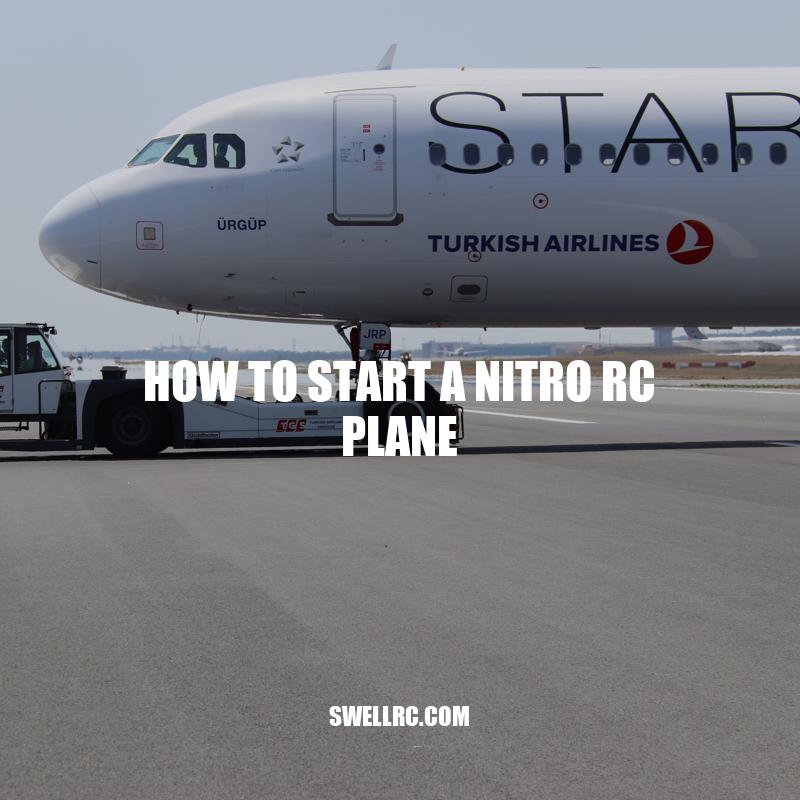Starting a Nitro RC Plane: A Step-by-Step Guide
Nitro RC planes provide an exciting and challenging form of radio control flying that many hobbyists enjoy. These planes come in different sizes and styles, but they all use a nitro fuel-powered engine to launch into the air. Starting a nitro RC plane can be a complex process, as you need to follow a specific set of steps to ensure that the engine runs smoothly and safely. If you are new to this hobby, it’s important to start with a basic understanding of how nitro RC planes work and the essentials of fueling, priming, starting and adjusting the engine. By familiarizing yourself with the steps involved, you can increase your chances of success and, most importantly, avoid accidents while flying. In this article, we will go through the step-by-step process on how to start a nitro RC plane, from fueling to shut down, so that you can start enjoying the thrilling experience of radio control flying.
Step 1: Fueling
The first step to starting a nitro RC plane is to fuel it up, and there are certain things you need to keep in mind:
- Use the right type of nitro fuel that is recommended by the manufacturer.
- Mix the fuel with the right amount of oil as per the instructions on the bottle or manual.
- Fill the fuel tank with fresh fuel and make sure it is emptied before adding new fuel.
- Keep the fuel away from open flames, sparks and heat sources.
- Make sure you store the fuel in a cool and dry place, with the cap tightly secured.
If you are not sure about the type of fuel to use or the mixing ratio, you can check the manufacturer’s website or manual for guidance. Make sure to follow all safety precautions and avoid spilling the fuel, as it can damage the plane’s components and pose a fire hazard.
How do you start a nitro RC?
Here are the steps to start a nitro RC:
1. Turn the transmitter and the receiver on.
2. Prime the engine by putting a few drops of fuel into the carburetor.
3. Pull the starter cord until the engine starts.
4. Adjust the high and low needles to get the right mixture.
5. Warm up the engine for a few minutes before driving.
For more detailed information and tips, visit the RC car forums, RC groups or websites like rcplanet.com or towerhobbies.com. They offer a wide selection of Nitro RC cars, parts, and accessories as well.
Step 2: Priming
The next step is to prime the engine, which ensures that the fuel flows properly to the engine. Here’s what you need to do:
- Locate the primer bulb, which is usually located near the carburetor.
- Squeeze the bulb several times until the fuel flows into the carburetor and the lines are filled with fuel.
- You may need to prime the engine multiple times, especially if you are starting it for the first time.
Did you know that nitromethane, the main ingredient in nitro fuel, is also used in drag racing and rocket fuel? It is highly combustible and can produce a lot of power, which is why it is a popular choice for high-performance RC planes. However, it is also important to handle it with care and follow all safety precautions.
| Nitro Fuel Type | Mixing Ratio |
|---|---|
| 10% Nitro | 18oz fuel + 2oz oil |
| 20% Nitro | 16oz fuel + 4oz oil |
| 30% Nitro | 14oz fuel + 6oz oil |
How do you prime an engine for the first start?
Here are the steps to prime an engine for the first start:
- Make sure the oil and other fluids are at their proper levels.
- Disconnect the spark plugs.
- Crank the engine a few times to distribute oil to engine parts.
- Reconnect the spark plugs and start the engine.
- Let the engine run for a few minutes, checking for leaks or unusual noises.
For more detailed information on priming an engine or other mechanical related topics, check out websites like Popular Mechanics or products like the Haynes Repair Manuals.
Step 3: Starting the Engine
Now that the plane is fueled and primed, it’s time to start the engine. Here’s how to do it:
- Place the plane on a flat surface and ensure the engine is facing away from you.
- Turn on the transmitter, receiver, and the plane’s power switch.
- Set the throttle to the lowest setting so that the engine does not rev too high.
- Use the starter to turn the engine over. This can be done manually or with an electric starter.
- Once the engine has started, keep the throttle low for a few seconds to allow it to warm up and distribute the fuel and oil mixture evenly throughout the engine.
Some RC plane starters have a built-in glow plug igniter, which makes starting the engine much easier. If you’re having trouble starting your engine, you may want to consider getting one of these starters. They are available in many hobby stores or online retailers.
Remember that starting a nitro RC plane can be tricky, especially if you’re new to the hobby. Don’t be discouraged if it takes a few tries to get the engine started. Be patient, and follow the instructions carefully. With practice, starting your nitro RC plane will become easier and more enjoyable.
What are the steps for starting an engine?
Starting an engine can be a simple process. Here are the basic steps to follow:
- Check the fuel and oil levels.
- Turn the key or push the ignition button, depending on the type of engine.
- Press the accelerator pedal once or twice to prime the engine.
- Release the handbrake or foot brake.
- Shift into gear and begin driving.
For more detailed information on starting specific types of engines, such as diesel engines or small engines, check out websites such as Dummies.com or Briggs & Stratton.
Step 4: Adjusting the Throttle
Once the engine has warmed up, you can adjust the throttle to get the plane moving. Before doing this, it’s important to keep in mind that with nitro RC planes, the throttle is very sensitive. Here are some tips for adjusting the throttle:
- Start with small movements until you get used to the throttle’s sensitivity.
- Be aware of wind conditions and adjust the throttle accordingly.
- If the plane is not moving or is moving slowly, increase the throttle gradually.
- If the plane is moving too fast, decrease the throttle and adjust the controls to stabilize the plane.
As you gain more experience with flying your nitro RC plane, you’ll learn how to make finer adjustments to the throttle and controls to perform tricks and maneuvers. You can also find helpful tips and tutorials online or from experienced hobbyists to improve your skills. There are many websites dedicated to the world of RC planes, where you can find resources, forums, and communities to connect with other enthusiasts. Some popular websites include RC Universe, RC Groups, and HobbyKing.
How does the throttle make airplanes go faster?
The throttle controls the amount of fuel and air that enters the engine, which ultimately determines the speed of the airplane. By increasing the throttle, the engine is able to burn more fuel and air, which creates a greater amount of energy to power the airplane forward.
However, it’s important to note that increasing throttle doesn’t necessarily mean that the airplane will always go faster. Other factors such as air density, altitude, and external forces such as wind resistance can all impact the speed of the airplane.
If you’re interested in learning more about the mechanics of airplanes and how they work, websites such as Boeing or Airbus offer detailed information and insights on their respective aircraft models.
Step 5: Shutting Down the Engine
After you’re finished flying your nitro RC plane, it’s important to follow the proper steps to shut down the engine. Here are the steps to follow:
- Lower the throttle and allow the engine to idle for a few seconds.
- Turn off the transmitter, receiver, and power switch.
- Disconnect the battery from the engine to prevent accidental starts.
Taking the time to properly shut down the engine will help extend the life of your plane’s parts and ensure that it’s ready for the next flight. If you notice any issues with your plane during or after a flight, it’s a good idea to check the manufacturer’s website or manual for troubleshooting tips. You can also find helpful forums and communities online where fellow hobbyists can offer advice and support. Finally, investing in high-quality parts, fuel, and accessories will help ensure that your nitro RC plane performs at its best and is safe to fly.
How long can Nitro RC plane fly?
It depends on various factors, such as the size of the fuel tank, the engine’s fuel efficiency, and the type of flying you do. Generally, a nitro RC plane can fly for 10-15 minutes before it runs out of fuel. However, with proper tuning and maintenance, some planes can fly up to 30 minutes.
- Flying at full throttle will consume more fuel and reduce flight time.
- Regularly maintaining your engine and fuel system can improve fuel efficiency.
- Flight time can also be affected by weather conditions, altitude, and pilot skill level.
If you’re interested in purchasing a nitro RC plane, be sure to check out reputable websites such as Horizon Hobby or Tower Hobbies for a wide selection of planes and accessories.
Conclusion
Starting a nitro RC plane can be an exciting and fulfilling hobby. By following the steps outlined in this article, you can safely and confidently get your plane up in the air. It’s important to remember to always prioritize safety and proper maintenance, as well as investing in high-quality equipment to ensure that your plane performs at its best. Remember to shut down the engine properly after each flight to keep your plane in top condition for future use.
If you’re new to the world of nitro RC planes, it can be helpful to connect with other hobbyists and enthusiasts to learn more tips and tricks for maintaining and flying your plane. There are many online forums and communities that you can join to connect with likeminded individuals and get advice on all things nitro RC.
In conclusion, starting a nitro RC plane is a thrilling experience that requires some basic knowledge and careful attention to detail. With a little patience and practice, you can enjoy hours of fun and excitement as you fly your plane through the sky.



